load capacity CHEVROLET S10 1996 2.G Owners Manual
[x] Cancel search | Manufacturer: CHEVROLET, Model Year: 1996, Model line: S10, Model: CHEVROLET S10 1996 2.GPages: 375, PDF Size: 20.73 MB
Page 113 of 375
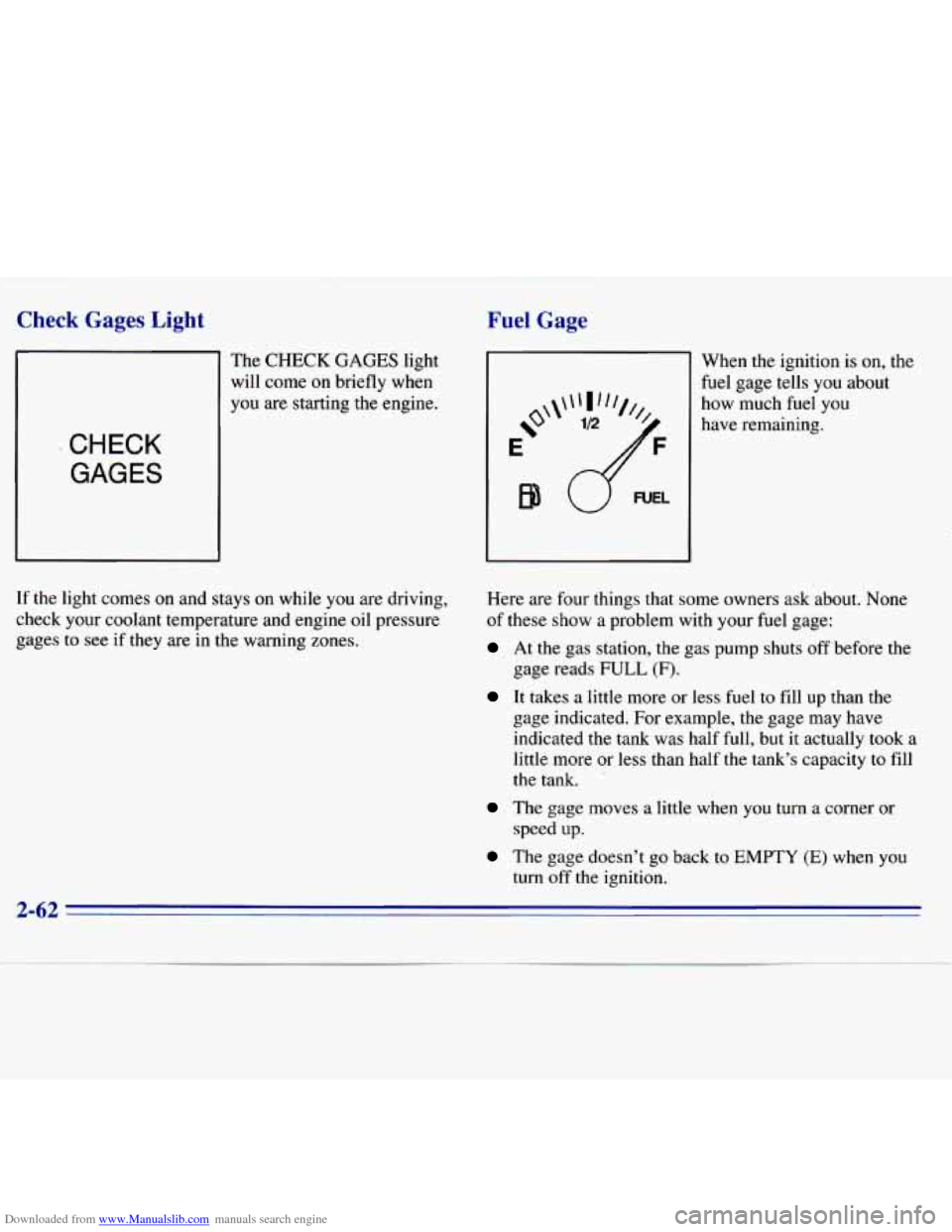
Downloaded from www.Manualslib.com manuals search engine Check Gages Light
The CHECK GAGES light
will come on briefly when
you are starting the engine.
CHECK
GAGES
If the light comes on and stays on while you are driving,
check your coolant temperature and engine oil pressure
gages to see if they are
in the warning zones.
Fuel Gage
When the ignition is on, the
fuel gage tells
you about
how much fuel
you
have remaining.
Here are four things that some owners ask about. None
of these show a problem with your fuel gage:
At the gas station, the gas pump shuts off before the
It takes a little more or less fuel to fill up than the
gage reads
FULL (F).
gage indicated. For example, the gage may have
indicated the tank was half full, but it actually took a
little more or less than half the tank’s capacity to fill
the tank.
The gage moves a little when you turn a corner or
speed up.
The gage doesn’t go back to EMPTY (E) when you
turn off the ignition.
2-62
Page 173 of 375
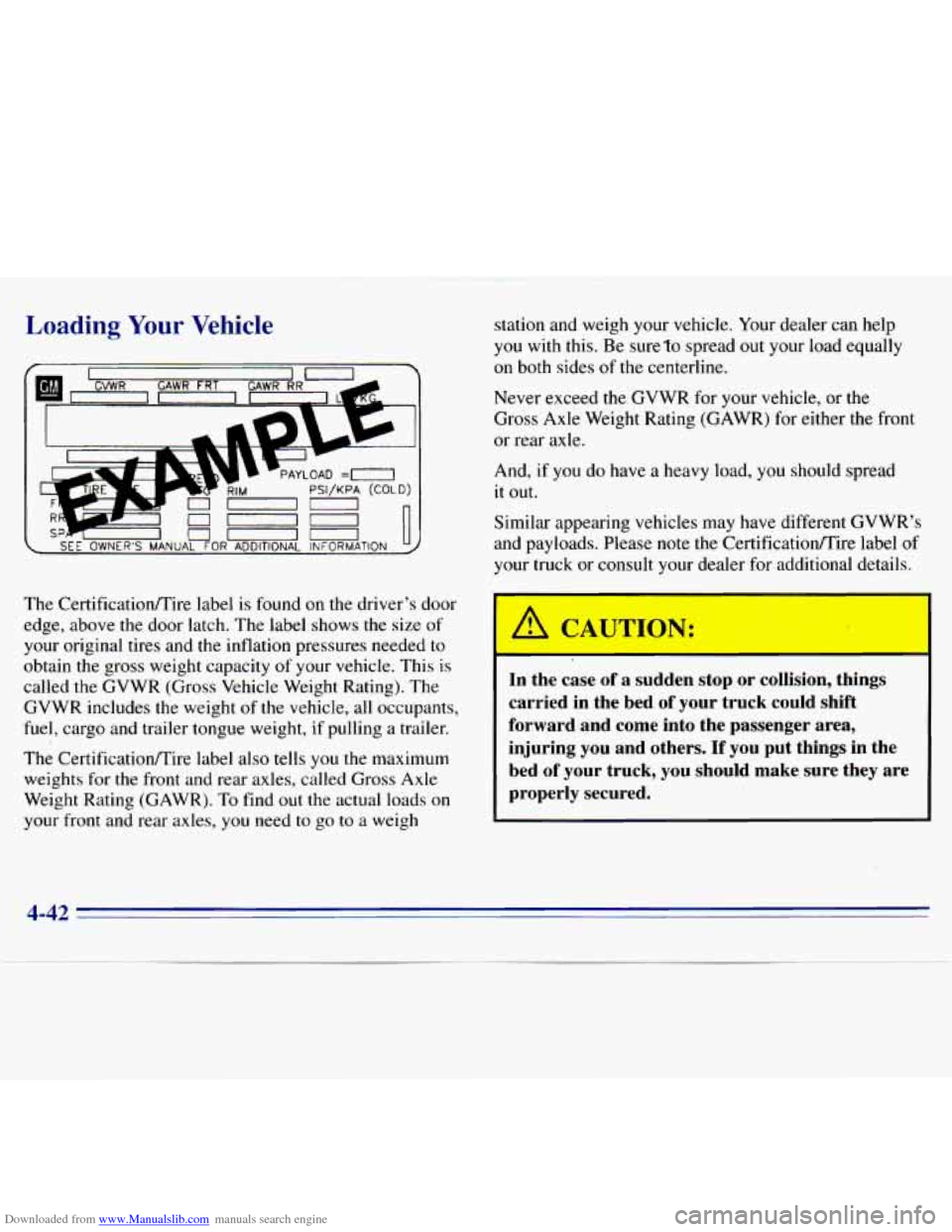
Downloaded from www.Manualslib.com manuals search engine Loading Your Vehicle
< SEE OWNER'S MANUAL FOR ADDITIONAL INFORMATION uu-
The CertificatiodTire label is found on the driver's door
edge, above
the door latch. The label shows the size of
your original tires and the inflation pressures needed to
obtain the gross weight capacity of your vehicle. This is
called the GVWR (Gross Vehicle Weight Rating). The
GVWR includes the weight
of the vehicle, all occupants,
fuel, cargo and trailer tongue weight, if pulling a trailer.
The Certificationmire label also
tells you the maximum
weights for the front and rear axles, called Gross Axle
Weight Rating (GAWR). To find out the actual loads
on
your front and rear axles, you need to go to a weigh station and weigh your vehicle.
Your dealer can help
you with this. Be sure'to spread out your load equally
on both sides of the centerline.
Never exceed the GVWR for your vehicle, or
the
Gross Axle Weight Rating (GAWR) for either the front
or rear axle.
And, if you do have a heavy load, you should spread
it out.
Similar appearing vehicles may have different GVWR's
and payloads. Please note the Certificationire label
of
your truck or consult your dealer for additional details.
I
. A CAUTION:
I
In the case of a sudden stop or collision, things
carried in the bed of your truck could shift
forward and come into the passenger area,
injuring you and others.
If you put things in the
bed of your truck, you should make, sure they are
properly secured.
4-42
Page 175 of 375
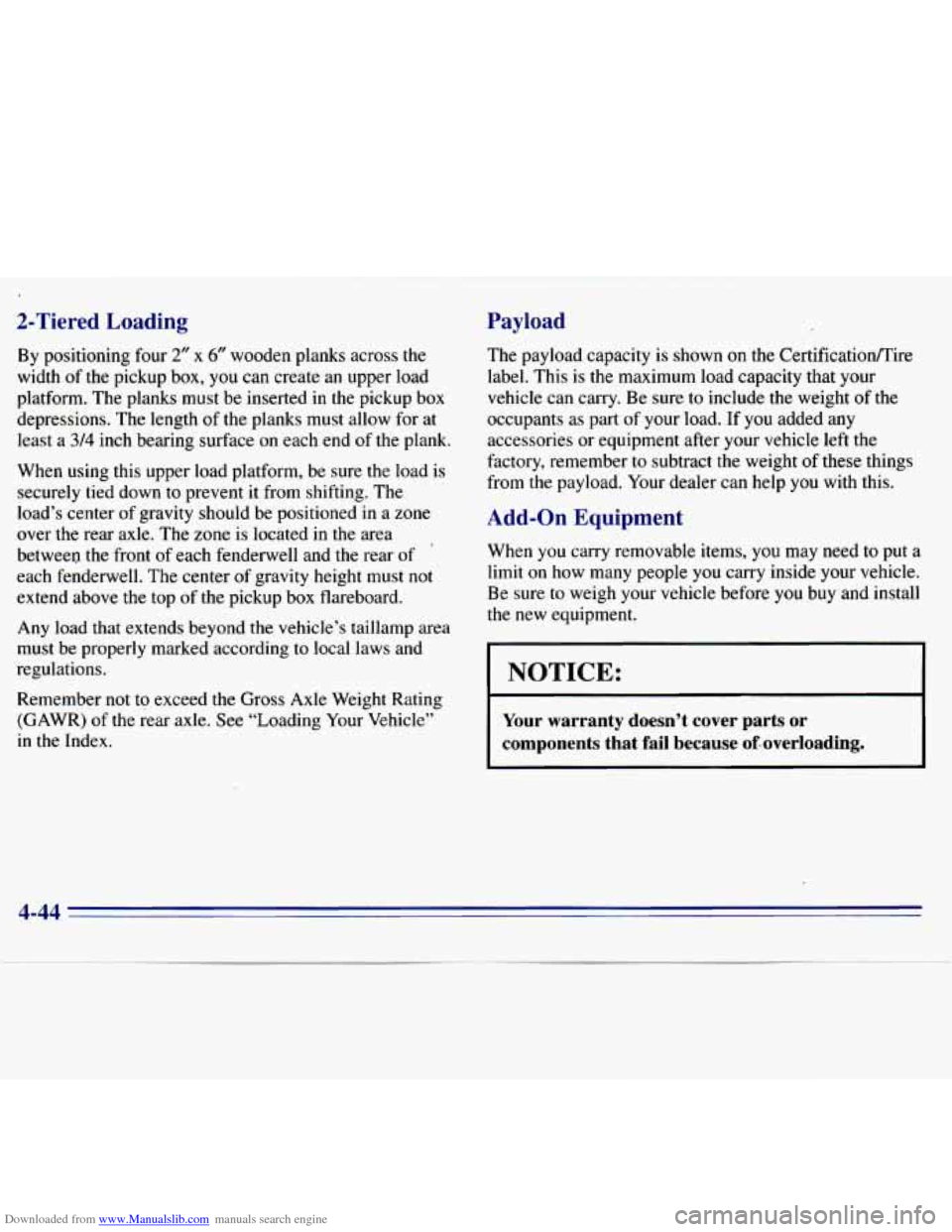
Downloaded from www.Manualslib.com manuals search engine 2-Tiered Loading
By positioning four 2” x 6” wooden planks across the
width of the pickup box, you can create an upper load
platform. The planks
must be inserted in the pickup box
depressions. The length of the planks must allow for at
least a
314 inch bearing surface on each end of the plank.
When using this upper load platform, be sure the load is
securely tied down to prevent
it from shifting. The
load’s center
of gravity should be positioned in a zone
over the rear axle. The zone is located
in the area
between the front
of each fenderwell and the rear of
each fenderwell. The center of gravity height must not
extend above
the top of the pickup box flareboard.
Any load that extends beyond the vehicle’s taillamp area
must be properly marked according to local laws and
regulations.
Remember not to exceed the Gross Axle Weight Rating
(GAWR) of the rear axle. See “Loading Your Vehicle”
in the Index.
Payload
The payload capacity is shown on the Certification/Tire
label. This is the maximum load capacity that your
vehicle can carry. Be sure to include the weight of the
occupants as part of your load. If you added any
accessories or equipment after your vehicle left the
factory, remember
to subtract the weight of these things
from the payload. Your dealer can help you with this.
Add-on Equipment
When you carry removable items, you may need to put a
limit on how many people you carry inside your vehicle.
Be sure to weigh your vehicle before you buy and install
the new equipment.
NOTICE:
I
Your warranty doesn’t cover parts or
components that fail because of, overloading.
4-44
~ .~ .
Page 181 of 375
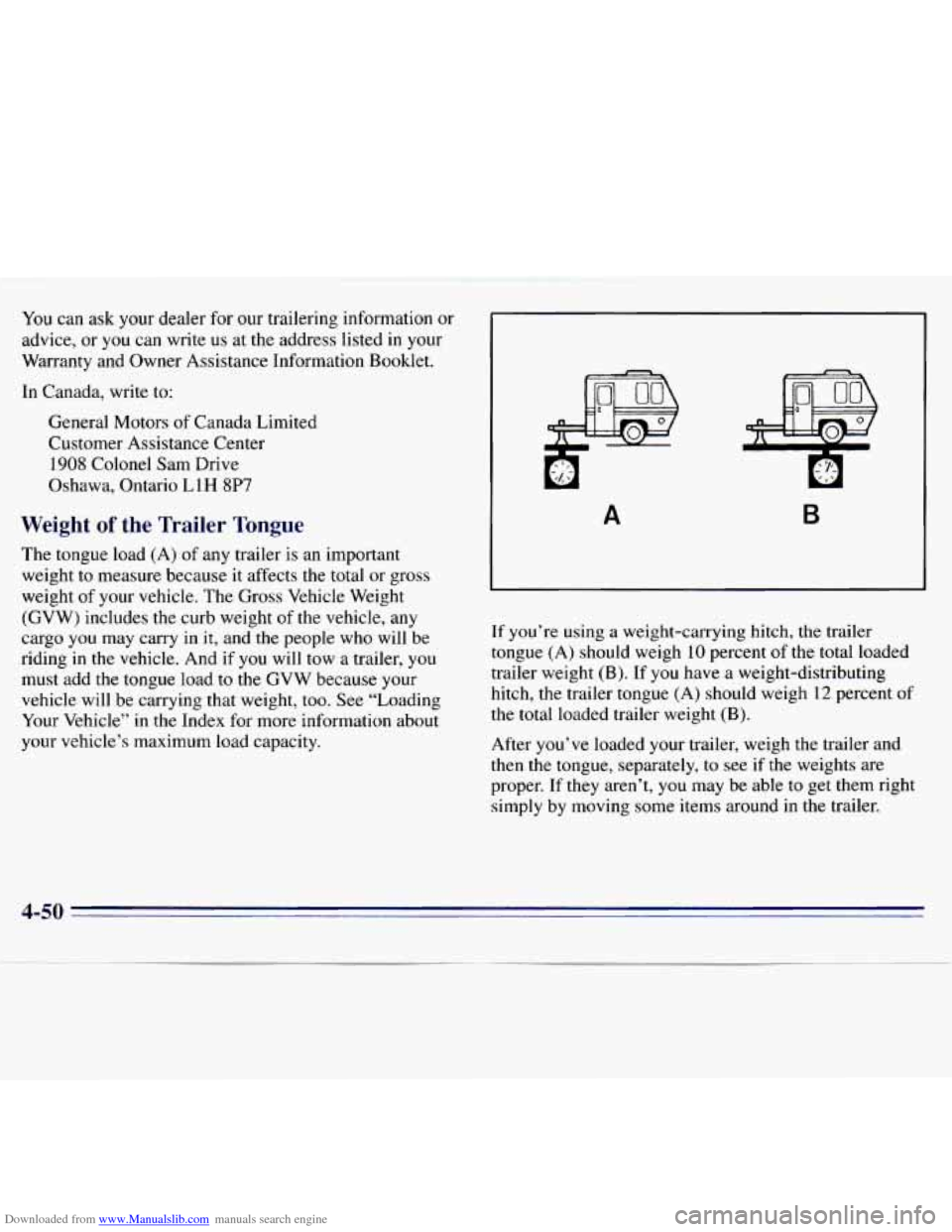
Downloaded from www.Manualslib.com manuals search engine ~
~ ~~ ~ ~~~ ~~ You can ask your dealer for our trailering information or
advice,
or you can write us at the address listed in your
Warranty and Owner Assistance Information Booklet.
In Canada, write to:
General Motors of Canada Limited
Customer Assistance Center
1908 Colonel Sam Drive
Oshawa, Ontario
LlH 8P7
Weight of the Trailer Tongue
The tongue load (A) of any trailer is an important
weight to measure because it affects the total or gross
weight of your vehicle. The Gross Vehicle Weight
(GVW) includes the curb weight of the vehicle, any
cargo you may carry
in it, and the people who will be
riding
in the vehicle. And if you will tow a trailer, you
must add
the tongue load to the GVW because your
vehicle
will be carrying that weight, too. See “Loading
Your Vehicle”
in the Index for more information about
your vehicle’s maximum load capacity.
A B
If you’re using a weight-carrying hitch, the trailer
tongue
(A) should weigh 10 percent of the total loaded
trailer weight
(B). If you have a weight-distributing
hitch, the trailer tongue
(A) should weigh 12 percent of
the total loaded trailer weight (B).
After you’ve loaded your trailer, weigh the trailer and
then the tongue, separately, to see if the weights are
proper.
If they aren’t, you may be able to get them right
simply
by moving some items around in the trailer.
4-50
Page 237 of 375

Downloaded from www.Manualslib.com manuals search engine When to Add Oil
If the oil is at or below the ADD line, then you’ll need to
NOTICE:
Don’t add too much oil. If your engine has so
much oil that the oil level gets above the
cross-hatched area that shows the proper
operating range, your engine could be damaged.
Just fill it enough to put the level somewhere in the
proper operating range. Push the dipstick all the way
back in when you’re through.
add some oil. But you must use the right kind. This
part
explains what hnd of oil to use. For crankcase capacity,
see “Capacities
and Specifications’’ in the Index.
6-11
Page 277 of 375
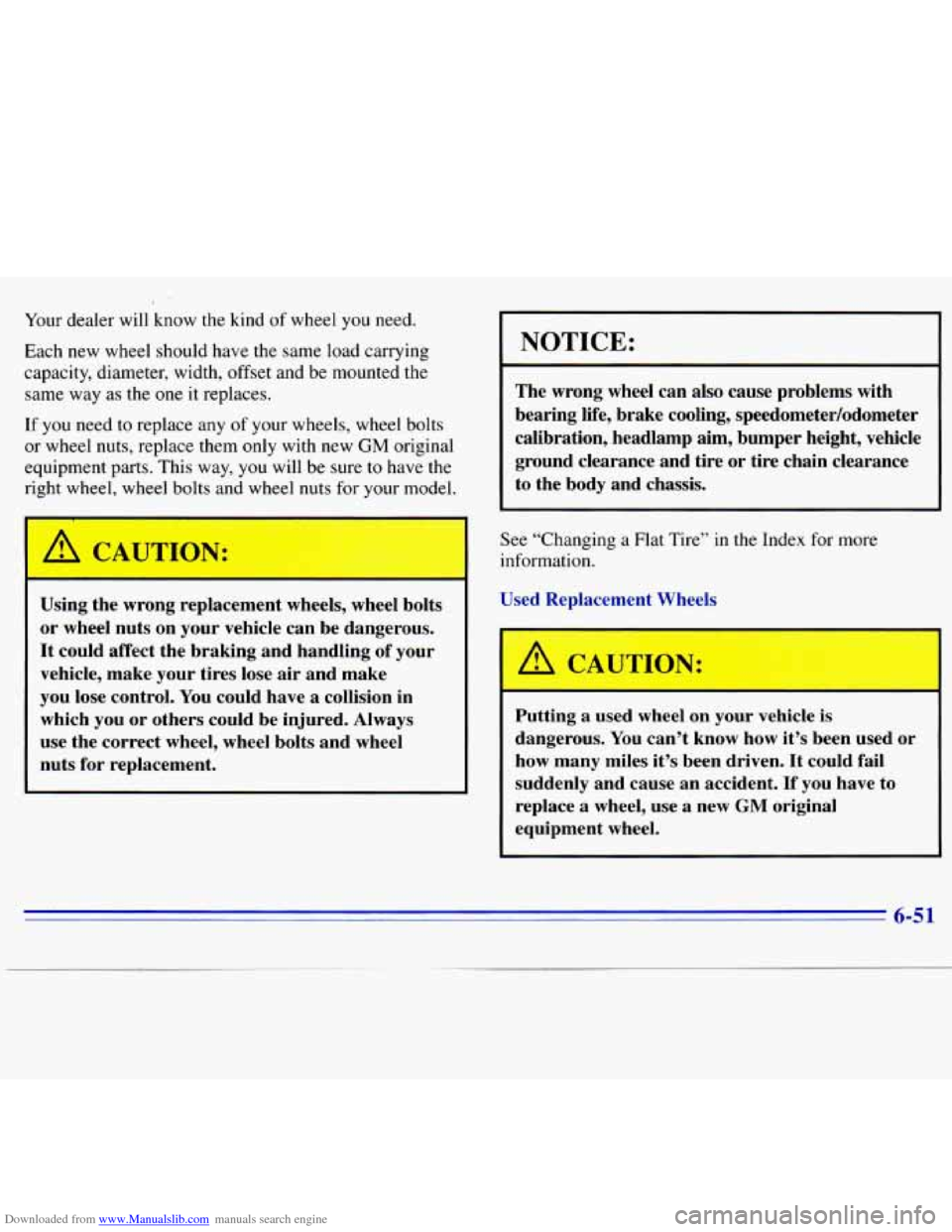
Downloaded from www.Manualslib.com manuals search engine Your dealer will know the kind of wheel you need.
Each new wheel should have the same load carrying
capacity, diameter, width, offset and be mounted the same way as the one it replaces.
If you need
to replace any of your wheels, wheel bolts
or wheel nuts, replace them only with new
GM original
equipment parts. This way, you will be sure
to have the
right wheel, wheel bolts and wheel nuts for your model.
Using the wrong replacement wheels, wheel bolts
or wheel nuts on your vehicle can be dangerous.
It could affect the braking and handling
of your
vehicle, make your tires lose air and make
you lose control.
You could have a collision in
which you or others could be injured. Always
use the correct wheel, wheel bolts and wheel
nuts for replacement.
NOTICE:
The wrong wheel can also cause problems with
bearing life, brake cooling, speedometer/odometer
calibration, headlamp aim, bumper height, vehicle
ground clearance and tire or tire chain clearance
to the body and chassis,
See “Changing a Flat Tire” in the Index for more
information.
sed Replacement
7 keels
Putting
a used wheel on your vehicle is
dangerous. You can’t know how it’s been used or
how many miles it’s been driven, It could fail
suddenly and cause an accident.
If you have to
replace a wheel, use
a new GM original
equipment wheel.
6-51
Page 294 of 375
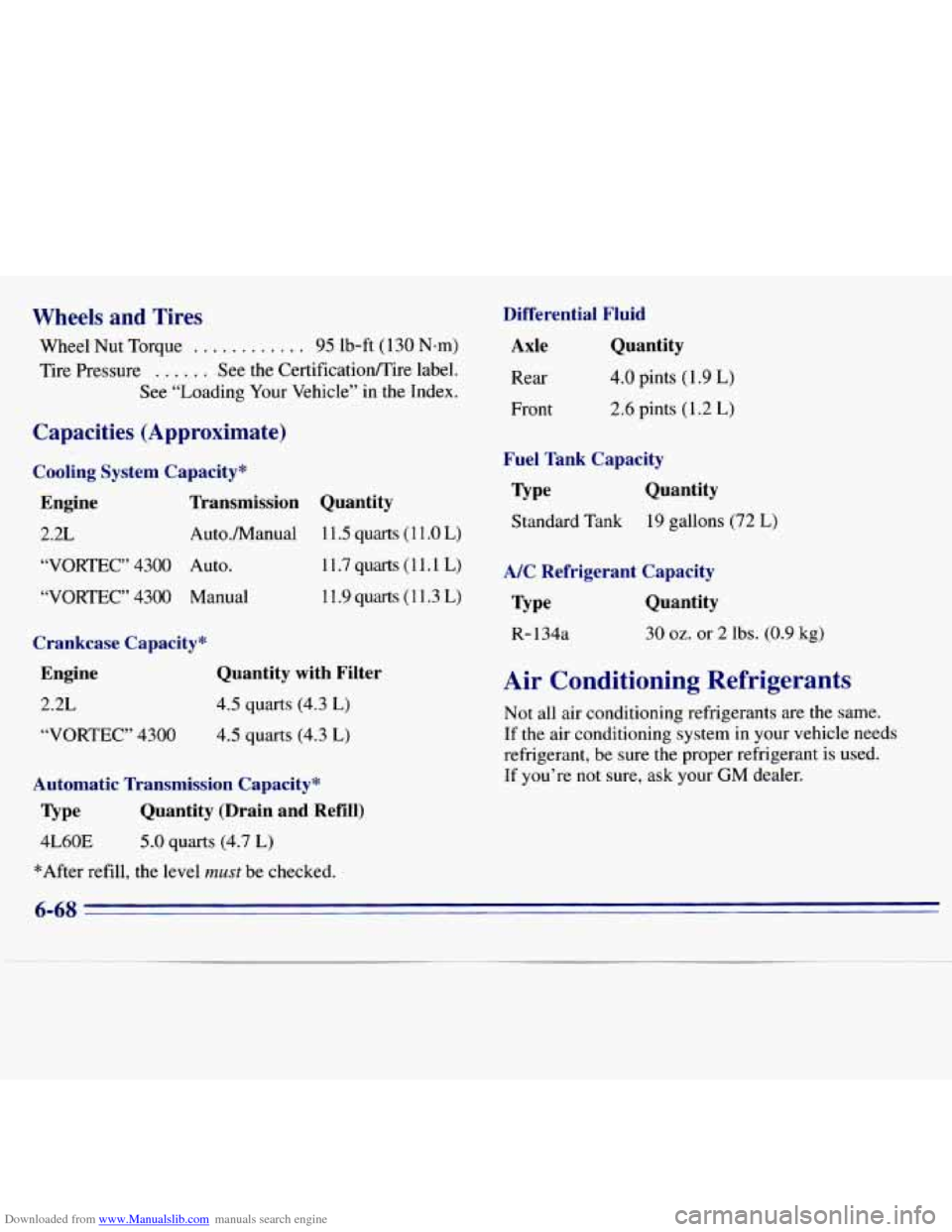
Downloaded from www.Manualslib.com manuals search engine Wheels and Tires
Wheel Nut Torque . . . . . . . . . . . . 95 lb-ft (130 N-m)
Tire Pressure . . . . . . See the Certificatiod‘Tire label.
See “Loading Your Vehicle”
in the Index.
Capacities (Approximate)
Cooling System Capacity*
Engine Transmission Quantity
2.2L Auto./Manual 1 1.5 quarts (1 1 .O L)
“VORTEC” 4300 Auto. 11.7quarts(11.1
L)
“VORTEC” 4300 Manual
11.9quarts(11.3L)
Crankcase Capacity*
Engine Quantity with Filter
2.2L 4.5 quarts (4.3 L)
“VORTEC” 4300 4.5 quarts (4.3 L)
Automatic Transmission Capacity*
Type Quantity (Drain and Refill)
4L60E 5.0 quarts (4.7 L)
*After refill, the level must be checked.
Differential Fluid
Axle Quantity
Rear 4.0 pints (1.9 L)
Front 2.6 pints (1.2 L)
Fuel Tank Capacity
Type Quantity
Standard Tank 19 gallons (72 L)
A/C Refrigerant Capacity
Type Quantity
R- 134a 30 oz. or 2 lbs. (0.9 kg)
Air Conditioning Refrigerants
Not all air conditioning refrigerants are the same.
If the air conditioning system in your vehicle needs
refrigerant, be sure the proper refrigerant is used.
If you’re not sure, ask your GM dealer.
6-68
Page 368 of 375
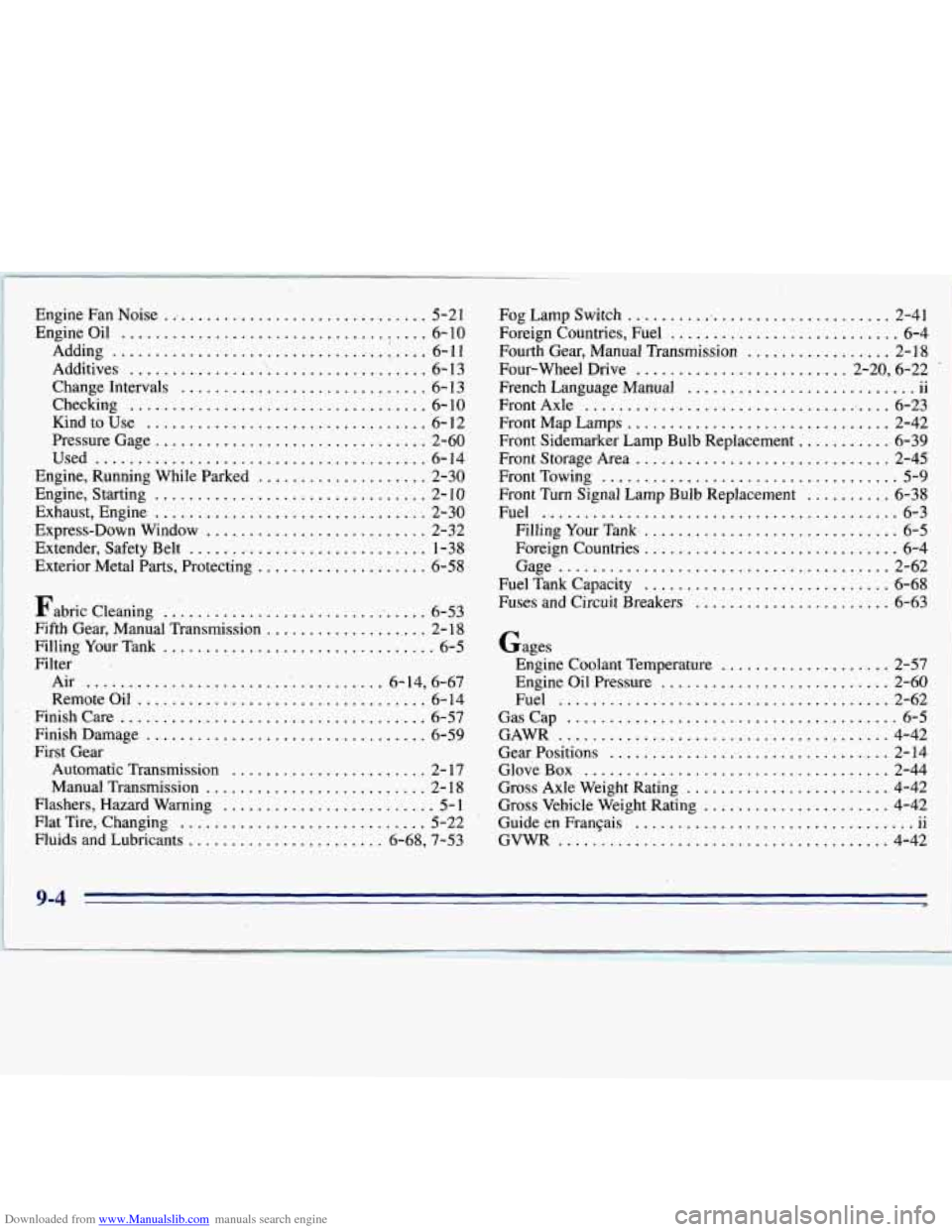
Downloaded from www.Manualslib.com manuals search engine Engine Fan Noise ................................ 5-2 1
Engineoil .................................... 6-10
Change Intervals ............................. 6- 13
Checking ................................... 6- 10
Kind to Use
.................................. 6- 12
Pressure Gage ................................ 2-60
Used ....................................... 6-14
Engine, Running While Parked .................... 2-30
Engine, Starting ................................ 2- 10
Exhaust, Engine ................................ 2-30
Express-Down Window .......................... 2-32
Exterior Metal Parts, Protecting .................... 6-58
Adding ....................................... 6-11
Additives ................ .I ................... 6- 13
Extender, Safety Belt ............................. 1-38
Fabric cleaning ................................. -6-53
Fifth GeBr. Manual Transmission .................... 2-18
Filling Your Tank ................................ 6-5
Filter
Air
.................................... 6-14, 6-67
Remote Oil .................................. 6-14
........................ 6-57
........................ 6-59
....................... 2-17
........................ 2-18
.......................... 5-1
........................ 5-22
................... 6-68, 7-53
Fog Lamp Switch ................................ 2-41
Foreign Countries. Fuel ........................... 6-4
Fourth Gear. Manual Transmission ................. 2-18
Four-wheel Drive ......................... 2-20. 6-22
French LanguageManual 11
Front Axle ...................................... 6-23
Front Map Lamps ............................... 2-42
Front Sidemarker Lamp Bulb Replacement ........... 6-39
Front Storage Area ............................... 2-45
.. ...........................
FrontTowing ................................... 5-9
Front Turn Signal Lamp Bulb Replacement .......... 6-38
Fuel .......................................... 6-3
Filling Your Tank ................................ 6-5
Foreign Countries .............................. 6-4
Gage ......................................... 2-62
Fuel Tank Capacity ............................. 6-68
Fuses and Circuit Breakers ....................... 6-63
Gages
Engine Coolant Temperature
.................... 2-57
Engine Oil Pressure ........................... 2-60
Fuel ....................................... 2-62
GasCap ....................................... 6-5
GAWR ....................................... 4-42
Gear Positions .................................. 2-14
GloveBox .................................... 2-44
Gross Axle Weight Rating ........................ 4-42
Gross Vehicle Weight Rating ...................... 4-42
Guide en Frangais 11
GVWR ....................................... 4-42
.. .................................
I
9-4